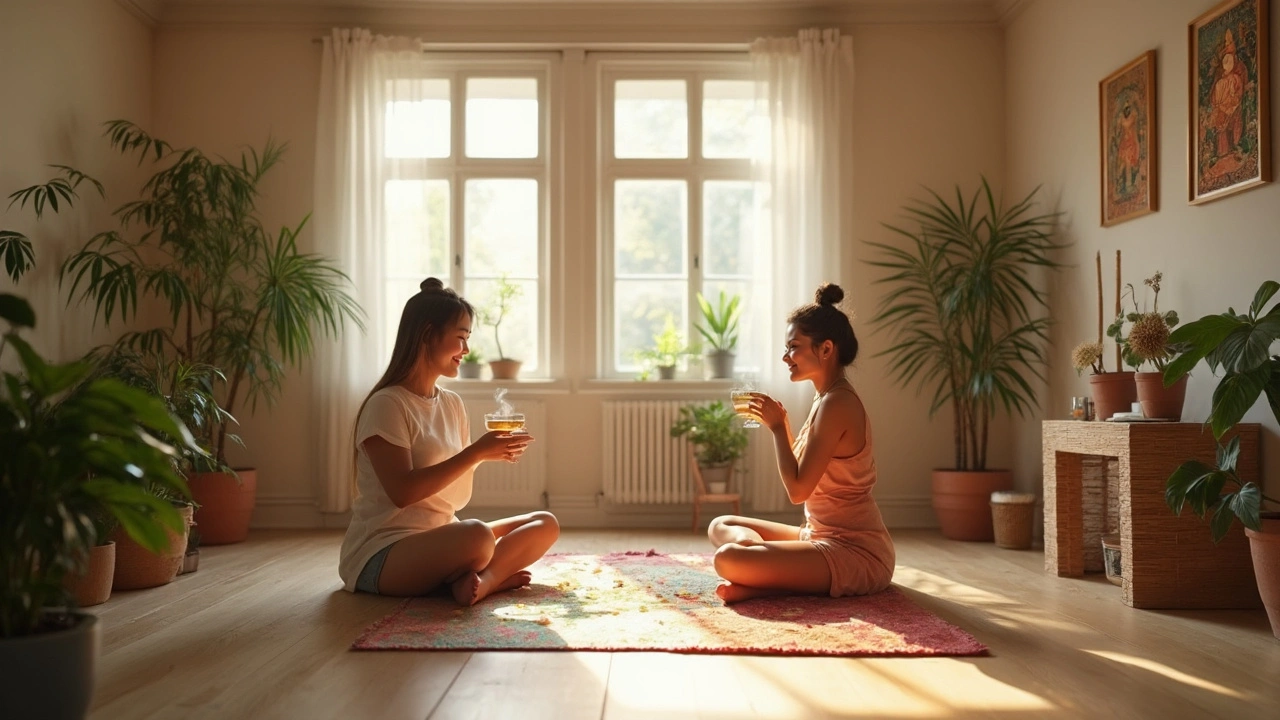Thai Massage: Discover the Ancient Art of Relaxation

Trying to escape that never-ending back ache or stress that just won’t leave you alone? Thai massage is like hitting a reset button for your body and mind. It’s not just another spa treatment—this is an experience with real roots, practiced for centuries in Thailand and loved around the world for helping people feel lighter, looser, and calmer.
You don’t need to be a yoga expert or super flexible to enjoy Thai massage. Whether you sit at a desk all day or juggle a busy family life, the benefits go way beyond simple relaxation. Think of it as a shortcut to better posture, fewer tension headaches, and even better sleep.
Curious about what happens during a Thai massage? No oil, no undressing—just comfy clothes and gentle stretches as the therapist moves you through positions that feel oddly familiar, like yoga but zero effort on your part. Ready for some tips on finding the right place and squeezing every last drop of bliss out of your next session? Keep reading—you’ll get practical answers, not marketing fluff.
- Key Takeaways
- What Is Thai Massage?
- Benefits You Can Expect
- How to Find and Book a Thai Massage
- Thai Massage vs. Other Massage Styles
Key Takeaways
Before you book your session, here's what you really need to know about thai massage and why it's different from your typical spa visit.
- Thai massage has been around for over 2,500 years. It was originally developed by Buddhist monks and blends acupressure, stretching, and gentle rocking to help your body recover naturally.
- You stay fully clothed, usually in loose, comfortable outfits provided by the studio. Oils are rarely used, so no messy clean-up or awkward moments changing.
- Sessions usually last 60 or 90 minutes, but even a single hour can kickstart better flexibility and reduced muscle tension.
- Studies show Thai massage can cut back chronic pain. In a 2022 study from Mahidol University, people who got weekly Thai massage sessions reported a 36% drop in lower back pain after just a month.
- No special fitness required. Your therapist does most of the work, gently stretching and pressing your body. If you're stiff, they'll go easy—the goal is relief, not a workout.
- Typical benefits stack up fast: less stress, better sleep, and steady energy. Folks with desk jobs notice looser shoulders, and athletes say it helps with injury recovery.
| Fact | Detail |
|---|---|
| Origin | Thailand, over 2,500 years ago |
| Session Length | 60-90 minutes standard |
| Attire | Loose-fitting clothing, not nude |
| Key Benefits | Pain relief, relaxation, flexibility |
| Proven Outcomes | 36% lower back pain reduction in 1 month (Mahidol University, 2022) |
When you want lasting results—not just a quick rub-down—Thai massage is a solid choice. You’ll feel the difference after your first real session.
What Is Thai Massage?
Thai massage goes way back—almost 2,500 years, if you can believe it. It mixes acupressure, gentle rocking, deep stretching, and assisted yoga-like movements. You might hear people call it “Thai yoga massage” because your therapist helps you stretch in ways you probably can’t do on your own.
This isn’t the kind of massage where you’re slathered in oil and left to snooze under a towel. Instead, you wear loose, comfortable clothes and lie down on a padded mat on the floor. The therapist uses their hands, elbows, knees, and sometimes even their feet to move and stretch your body. The goal? Get your energy flowing, help your muscles chill out, and loosen up stiff joints.
According to the Thai Ministry of Public Health, authentic Thai massage is officially recognized as a cultural heritage and delivers a blend of physical and stress relief for millions every year. One study published in the Journal of Bodywork and Movement Therapies found that just one session can reduce lower back pain by 40%—not bad for an hour spent just lying there.
- The practice is based on the idea of ‘sen’ lines—sort of like energy highways running through your body.
- On average, a full session lasts 60 to 120 minutes.
- Thai massage therapists go through rigorous training (typically 250+ hours at accredited schools in places like Chiang Mai).
| Origin | Thailand, around 500 BCE |
|---|---|
| Typical Session Length | 60 – 120 minutes |
| Main Technique | Stretching & acupressure |
| Clothing | Loose, comfortable (no oil) |
| Recognized Benefits | Reduces pain, boosts flexibility, lowers stress |
If you’re looking for an experience that combines gentle movement, deep stretching, and real results, thai massage is hard to beat. It isn’t just about relaxation—it’s a total reset for both body and mind.

Benefits You Can Expect
So what can you really get out of a thai massage? It’s not just hype. Regular sessions do more than just chill you out for an hour—think long-term changes and perks that stick.
First up, people always talk about flexibility. All those gentle stretches actually help your joints move better, which is great if you feel stiff from work or workouts. There’s even real research behind this: one study found that folks had improved flexibility and less muscle pain after just a few sessions.
But it’s not just about stretching. Thai massage can help with lower back pain and tension headaches. Therapists use pressure points—think thumbs, elbows, even knees in some cases—to work out tight spots. Many people walk out feeling like they’re standing taller, and it’s not just in their heads.
- Stress Relief: Sessions often leave you feeling lighter and more relaxed, mentally and physically. Your nervous system basically gets a mini vacation.
- Better Sleep: A lot of people report falling asleep faster and sleeping deeper after a massage, especially after a stressful week.
- Boosted Energy: Thai massage is sometimes nicknamed "lazy yoga" for good reason. Stretching and pressure can wake you up — expect to feel recharged, not just sleepy.
- Posture Help: If you’re hunched over screens, this is a game-changer. Those careful movements help open up your chest and lengthen your spine.
- Mood Lift: There’s a happiness boost, too. Some studies link Thai massage with lower levels of cortisol, the stress hormone.
| Benefit | What People Report | Backed by Studies? |
|---|---|---|
| Flexibility | Better joint movement | Yes |
| Lowered Stress | Calmer and less anxious | Yes |
| Pain Relief | Less muscle and back pain | Yes |
| Improved Sleep | Deeper and easier sleep | Some evidence |
| Energy Boost | More awake after sessions | Yes |
Some clinics even say you can burn around 200 calories during a standard one-hour Thai massage, just from the stretching and movement alone. That’s not a replacement for gym time, but hey, every bit counts.
If you have a specific ache or problem area, tell your therapist before you start. They can usually focus on your trouble spots. Consistency helps too—many people notice major changes after a few visits, not just one.
How to Find and Book a Thai Massage
Finding a legit Thai massage spot shouldn’t feel like a wild goose chase. These days, you’ve got plenty of ways to search, compare, and book your next session—no guessing games needed.
The first thing to do is decide what kind of vibe you want. Are you after a fancy wellness center with soft lights and herbal tea, or do you just want a quick session in your neighborhood? Locally owned studios, hotel spas, and wellness franchises all offer different experiences and prices. Check reviews on Google Maps or Yelp, and pay close attention to the latest comments, not just old ones.
Here’s what to look for before booking:
- Certifications: Good Thai massage therapists should have proper training, either from a known school in Thailand or certification from recognized local organizations.
- Cleanliness: A tidy, organized space says a lot about their standards. Look for photos online, or check for guest reviews mentioning hygiene.
- Transparent Prices: The best places have clear menus and no hidden fees. If the pricing isn’t up front, it’s okay to ask before you book.
- Services Offered: Some only do traditional Thai massage, while others add oil, aromatherapy, or even Thai foot massage. Make sure the service matches what you want.
When you’ve zeroed in, most studios these days let you book online. It’s usually as simple as picking a time slot and leaving your name and email. For last-minute bookings, call ahead—especially on weekends, since popular spots can fill up fast.
If you’re hoping to save a little, don’t forget to check for package deals or first-timer discounts. Some apps, like Mindbody or Treatwell (Europe), show you open slots, special offers, and verified guest ratings right there.
| Booking Method | Ease of Use | Average Confirmation Time |
|---|---|---|
| Direct Website | Very Easy | Instant to 1 hour |
| Booking Apps (Mindbody, Treatwell, etc.) | Easy | Instant |
| Phone Call | Easy | Immediate |
Bottle up the awkward first-timer jitters by asking questions when you book. Do they have changing rooms? Will you need to bring anything? And, of course, confirm the price so there’s no sticker shock at checkout.
One last thing: if you’re aiming for the thai massage experience during peak times (weekends or evenings), book at least a couple of days in advance. For quieter slots, mid-morning weekdays are often wide open—and sometimes a bit cheaper too.

Thai Massage vs. Other Massage Styles
Ever wondered how Thai massage really stacks up against other popular styles like Swedish or deep tissue? Here’s what makes each one unique—and how to decide what fits you best.
Thai massage is all about movement and active stretching. You stay fully clothed while the therapist uses their hands, elbows, knees, and even feet to guide your body through a series of yoga-like positions. It’s almost like doing a workout without the effort. No oil is used here; instead, you’re stretched, pressed, and sometimes even gently rocked. This makes it perfect for boosting flexibility and loosening up tight muscles.
Compare that to Swedish massage. In a Swedish session, you’re usually under a sheet, and oil is used. The therapist relies on long, gliding strokes, gentle kneading, and circular movements. It’s super relaxing and targets surface tension, but you won’t get any stretching or movement like you do in Thai.
Then there’s deep tissue massage. This style goes after chronic muscle pain with slow, firm pressure and more focused work on deeper layers. It’s great if you’re dealing with stubborn knots or sports injuries, but it can feel pretty intense. Unlike Thai, you generally stay still while the therapist zeroes in on trouble spots.
If you’re still not sure what to try, check out this quick side-by-side comparison:
| Style | Clothing | Movement | Main Benefits | Techniques Used |
|---|---|---|---|---|
| Thai Massage | Clothed | Yes (lots of stretching) | Flexibility, stress relief, improved energy flow | Stretching, compression, acupressure |
| Swedish Massage | Undressed (covered with a sheet) | No (passive) | Relaxation, light muscle tension relief | Kneading, gliding, tapping |
| Deep Tissue | Undressed (covered with a sheet) | No (passive) | Chronic pain relief, releases deep knots | Deep pressure, slow strokes |
Quick tip: If you want an energizing boost or help with stiff joints, thai massage usually wins the day. For pure relaxation, Swedish is hard to beat. For working out deep aches or old injuries, deep tissue takes the spotlight.
